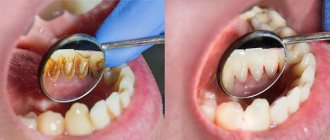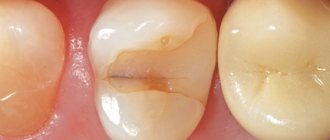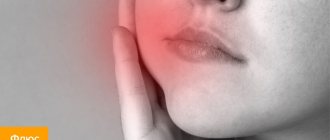Dental depulpation is a common dental procedure, the essence of which is to remove the nerve. It is carried out for advanced caries, periodontitis and pulpitis in order to stop the spread of the inflammatory process, preserve healthy dental tissues and prevent tooth extraction.
It is believed that a pulpless tooth completely loses sensitivity. However, practice shows that this is not always true. We'll tell you why tooth sensitivity may persist after nerve removal and how to solve this problem.
Why can a tooth hurt if the nerve has been removed a long time ago?
In medical practice, there are cases when a tooth that was pulpless a month, or even a year ago, suddenly begins to hurt. At first, it may be a barely noticeable discomfort, a reaction to hot or cold. However, soon the unpleasant sensations develop into acute pain, in addition, it often comes to swelling, suppuration and tumors. An unambiguous answer to the question “why does a tooth that has been healed for a long time begin to hurt?” difficult - doctors currently cite several of the most common and obvious reasons:
- Incomplete depulpation
. In other words, if for some reason the nerve was not completely removed, sooner or later it will definitely make itself felt. The process of pulp removal is very complex, requiring maximum precision and care from the doctor. In this case, experience also plays an important role - a young specialist who is thoroughly familiar with the theory is unlikely to be able to cope with this task better than a dentist seasoned by many years of medical practice. If the nerve is not completely removed, over time you will inevitably have to deal with pain and a variety of complications. By the way, if the patient has a pronounced reaction of the tooth to cold or hot, most likely it is the nerve that has not been completely removed. - Poor quality filling after depulpation.
This reason is also quite common in medical practice. For a better understanding of the situation, let us explain: the root canal of a tooth has a thickness of 0.5 to 1 mm, in an expanded form (after processing with special tools) - up to 2 mm. The shape and bends are individual for each individual channel - they can be straight, with bends, with creases. It is not always possible to see this on an x-ray, so the doctor has to work “blindly”, by touch. It is not surprising that in some cases part of the canal remains unfilled. And it is in this part that bacteria accumulate over time, causing inflammation and leading to pain. Also, the filling itself may not lie tightly, allowing access to pathogenic microorganisms. - Increased pressure on the tooth
. The tooth does not just stand in the jaw bone - it is attached to it by numerous threads of connective tissue. If during the filling process the doctor installs a filling that is too high, then the chewing load on this tooth will increase significantly, which, accordingly, will increase the load on the ligaments. Over time, the increased pressure will turn into a constant aching pain, especially evident when pressed. - Infection
. If we assume that the nerve has been completely removed and all the canals have been thoroughly cleaned and securely sealed, there is only one option left - the activity of pathogenic bacteria that entered the root canals and then into the jaw tissue during the treatment of caries or pulpitis. - Insufficient hygiene
. After high-quality depulpation, the patient needs high-quality regular oral hygiene. Even under the most reliable filling, bacteria can accumulate over time if you do not brush your teeth in a timely manner. Some patients believe that dental plaque does not accumulate on the filling material and is not afraid of tartar. In fact, this is not so - bacteria have an equally destructive effect on both tooth enamel and artificial fillings. The infection can get to the root of the tooth and from the gums - this is especially true for people suffering from periodontal diseases. - In fact, one of the neighboring “living” teeth hurts
.
Naturally, it takes time for bacteria to accumulate in an unfilled canal or for an infection to make itself felt. It is likely that a tooth can get sick in a year or after 5 years - it all depends on the degree of neglect of the problem, as well as on the individual characteristics of the body (people with strong immunity tolerate inflammation much easier, so they may not notice alarming manifestations for longer).
In any of the above cases, the tooth will have to be re-treated - the filling will have to be removed, the canals will have to be cleaned and filled again. In addition, a number of additional disinfection measures will have to be carried out.
Features of dental nerve removal
On a note! Upon completion of the manipulations, the doctor must evaluate the result. For control, an x-ray is taken again, from which the dentist makes a conclusion about the quality of treatment. After a properly performed operation, the pulpless tooth will serve the owner for many years and can even become a support for a prosthesis.
Why does pain occur after removal?
Experts identify several factors that cause pain in a sealed tooth without a nerve - this can be either a normal condition or a pathological one. To be able to distinguish them, you should know some nuances.
It is normal to feel painful discomfort in the first few days after visiting the dental office. Under the influence of the drill, healthy dental tissues heat up, hence the unpleasant sensations. Pain occurs with pressure or during eating - for one to three days or a week.
Important! Pain may be the result of a complication, injury, inflammation, or an error made by the doctor at some stage of treatment. If the pain does not go away even after two to three weeks or suddenly arises a few days after the procedure, especially at night, this is a reason to contact the clinic.
The dentist must determine the cause and prescribe treatment if necessary. The filling will likely need to be removed and the root canals re-treated. In any case, it is better not to delay going to a specialist.
Pain after dental treatment
The main causes of pain in the root of a tooth without a nerve are presented below.
1. Damage to periodontal tissue
When processing canals with special instruments, their edges may go beyond the border of the root and touch sensitive tissues. Also, unpleasant sensations can be caused by a small amount of antiseptic getting outside the root canal, which the dentist uses to disinfect the treated cavities. Such procedures involve the use of potent drugs, and their effects may well cause irritation. If the dentist did everything correctly, in both cases considered, the pain usually goes away after a few days.
2. Unsatisfactory canal filling
As a result, internal inflammation often develops, which is visible only on an x-ray. There are two possible reasons. First: the canals were not completely sealed. If during filling there are voids in the canal, areas that are not completely filled, over time harmful bacteria will begin to multiply in them, which will cause inflammation. The spread of infection can lead to the accumulation of pus at the root and the occurrence of periodontitis. The second reason suggests that the filling material has reached beyond the root apex, which also contributes to severe discomfort.
3. A piece of dental instrument remains in the root canal
During expansion, cleaning or filling, a piece of one of the devices could break off and get stuck in the canal. In most cases, this happens due to the fault of the doctor - if he violates the technique of working with the instrument. The exception is when the dentist deals with curved canals. Sometimes it is possible to get the piece out, but if it gets too deep, it will be impossible to remove it. The presence of a foreign object, even a tiny one, will prevent the specialist from performing the filling properly. This means that voids form in the canal, which will become a springboard for the proliferation of microbes and the occurrence of inflammation. Over time, it will spread to the periodontium, and if left untreated, to the jaw bone and soft tissues.
What to do with prolonged pain?
If you have a pain in a filled tooth without a nerve, and the pain does not go away within a few days, you should seek medical help. Most often, the problem can be solved, otherwise the dentist will suggest removing the affected unit of the dentition and installing an implant or dental bridge.
How does dental retreatment occur?
Depending on the cause of the ailment, there are several ways to relieve the patient of pain under a filling in a healed tooth without a nerve:
if the canals are not completely sealed, you will have to treat again - removing the old filling material and installing a new one. This must be done as quickly as possible, otherwise inflammation on the roots will lead to the loss of an incisor or molar. In addition, the specialist may decide to perform a surgical resection of the upper part of the root. Then there will be no need to carry out all the manipulations again if the filling material gets outside the canals: everything will depend on the amount of the substance. If there is only a small amount of it, the pain usually subsides naturally, and the tooth does not need to be re-treated. It is acceptable if mild discomfort continues for up to one to two months. Whether it is necessary to wait until the pain goes away on its own and treat immediately - this is decided by the doctor, focusing on the dynamics of the patient’s sensations. If the pain gradually disappears, it is likely that you will not have to repeat the manipulations.
If a lot of material gets outside the root, the doctor often performs an operation to cut off the tip of the root. To remove particles of filling material, the dentist makes a hole in the jawbone and removes excess material through it. It sounds scary, but in practice it is not the most difficult procedure. It lasts no more than an hour if a piece of the instrument remains in the canal: professional dentists try to remove the foreign body immediately after detection in order to prevent complications. The fragment is removed using ultrasound, the waves of which knock the particle out of the canal.
Another method involves creating a new channel close to the stuck debris. It is expanded, disinfected and the instrument is removed through it. It is also possible to use the method of resection of the root apex already described above and remove it along with the stuck piece if perforation has occurred: this is the most difficult case, requiring filling with a special expensive material. If the occurrence of perforations was caused by a dentist, the medical organization must correct the situation at its own expense.
Filling can be carried out both in the standard way - from inside the dental cavity, and from the outside, creating access to the perforated area through surgery, if an allergy to the filling material is detected: the patient can be relieved of pain only after repeating the treatment procedures with replacing the filling substance. Reaction to hot food: is this possible? There are known cases when hot food or drinks cause pain in a pulpless tooth. Normally, this should not happen, because the doctor removed the pulp, which made the unit of the dentition insensitive to thermal influences.
However, if particles of nerve tissue remain inside, sensitivity may persist and cause discomfort. Another scenario: inflammation from the pulp has spread further, and exposure to hot foods or liquids causes pain in these tissues. To accurately determine the cause, you should contact a professional. X-rays and examination using a special microscope will help identify the source of residual sensitivity.
Why can a tooth hurt immediately after nerve removal?
It also happens that immediately after the end of the anesthesia (and the procedure for removing nerves is invariably accompanied by the use of local anesthetics), the patient begins to experience acute pain in the dead tooth. There may be several reasons for this:
- The filling material got from the root of the tooth onto the soft gum tissue . This situation can occur if the material is fed into the root canals under very high pressure. In addition, this often occurs due to incorrect measurement of the channel length. To avoid this problem, it is necessary to take pictures before and after depulpation, and if defects are detected, immediately remove the filling, remove excess paste and reseal the canals.
- Remains of dental instruments in the canal . The needles for widening the canals and removing nerves are very thin. Even though modern instruments are made from high-quality materials, there is a small chance that a small piece of needle will remain in the canal, causing discomfort and pain.
- Damage to the tooth root . During the process of cleaning canals and removing nerves, there is a possibility of drilling through the root of the tooth, resulting in an open cavity leading directly into the jawbone (which, by the way, can also be damaged due to drilling too deep).
- The body's reaction to filling material . Or simply an allergy. Anyone can encounter this, especially if the patient has not previously had to deal with dental intervention. In this case, it is necessary to urgently remove the filling and repeat the procedure using a different material.
All of the above causes of tooth pain after nerve removal are pathological and require urgent medical intervention.
It is important to understand that immediately after treatment, a tooth with a removed nerve may hurt for some time for a number of reasons:
- Depulpation is a process of violating the integrity of nerve tissue, which cannot be completely painless. After the local anesthesia wears off, the patient still feels discomfort and aching pain for some time, which can be relieved with toothache tablets.
- A reaction to cold and hot things in the first couple of days after nerve removal is normal. Due to the violation of the integrity of the tooth tissue, its sensitivity also increases, which goes away after complete healing.
In order for the recovery period to pass quickly and painlessly, it is necessary to strictly follow the recommendations of the attending physician - do not drink or eat for 2 hours after the operation, observe the rules of hygiene, take anti-inflammatory and painkillers.
When should you see a doctor?
Dentists themselves recommend not delaying a visit to the clinic if the slightest alarming symptoms occur:
- Acute throbbing pain in the first hours after depulpation.
- The presence of edema, a swollen cheek or gum, the formation of an abscess under a tooth without a nerve.
- Manifestation of tooth reaction to cold and hot long after dental intervention.
- The pain after the operation does not subside, but on the contrary, it becomes stronger.
- An increase in body temperature (indicates the presence of an inflammatory process).
- Pain when pressing on a tooth or chewing.
If you contact an experienced doctor in a timely manner, any problems can be solved as soon as possible.
Causes of discomfort
Discomfort in the first days after treatment of a tooth with pulp removal is normal. If the discomfort gradually intensifies and does not go away within 3-5 days, you should consult a dentist. Causes of pain can be:
- incomplete pulp removal,
- allergic reaction to drugs,
- severe damage to dental tissues as a result of opening of the pulp chamber,
- compression by filling material,
- penetration of infection into the root canals.
To find out why tooth sensitivity persists after nerve removal in your case, you need to contact a dental clinic.
Why does a tooth hurt when pressed?
If the tooth does not bother you until you start chewing or pressing on it, most likely the reason lies in problems with the ligaments that “attach” the tooth to the jawbone, or due to slight swelling that will subside in a few days.
However, there are other reasons:
- A fragment of a dental needle remained in the canal.
- Excess filling material has gone beyond the root of the tooth and landed on the jaw bone.
- The nerve was not completely removed (in this case the tooth hurts even with light tapping).
- During the treatment of caries, an infection got into the root canals.
If you feel a sharp pain when pressing, it hurts to chew and even speak, you must urgently go to the clinic, take an x-ray and repeat the operation to clean and fill the canals, having previously eliminated possible foci of inflammation.
We correct other people's mistakes. Dental retreatment with a 10% discount
Moscow
What complications may arise?
Pain is one of our body's defense mechanisms. If there is pain, it means one of the systems is not working correctly, and there is a certain pathology. If you do not pay attention to these signals for help in time, you may encounter serious complications:
- Inflammation under the tooth
. At first it will be concentrated in one place. But in the absence of proper treatment, it will spread to nearby tissues, and then, through the bloodstream, throughout the body. - Infection of adjacent teeth
. If the cause of the pain is the proliferation of pathogenic bacteria, it is likely that the infection will spread to the soft tissue of the gums and then spread throughout the entire oral cavity.
If, after removing a nerve, a wisdom tooth hurts, then, contrary to popular belief, it is not necessary to remove it - if it is possible to repeat the treatment, eliminating the source of infection and inflammation, the doctor will definitely do everything in his power to save the tooth.
In the most advanced cases, the doctor usually decides to remove the filled tooth.
How to relieve pain?
The process of treating a damaged tooth is very complex and time-consuming. It often takes several visits to the doctor to completely eliminate the cause of the pain. At the same time, in order to somewhat reduce pain, it is quite acceptable to use painkillers, especially considering the fact that most of them also have an anti-inflammatory effect:
- Ibuprofen.
- Aertal.
- Ketanov.
- Nimesil.
- Nise.
- Paracetamol (may help with moderate pain).
In addition, you can numb an open tooth using special lidocaine-based sprays.
Don’t forget: pain relief is just a means to eliminate discomfort, but unfortunately, no pill, even the strongest and highest quality, can cope with the source of the disease.
Reasons why a “dead” tooth hurts
Most often, the complication is associated with poor quality work by the dentist. It is very important to treat the canals correctly. There should be no air pockets left in them. Otherwise, very soon pathogenic microorganisms will penetrate there and begin to actively multiply.
Among the most common causes of pain after depulpation:
- Incomplete closure of dental canals. Such a medical error does not make itself felt immediately. At first the patient enjoys a healthy smile, but at some point the situation changes. Sometimes poor-quality filling results in the formation of a cyst or granuloma. These are quite dangerous complications.
- The installed filling extends beyond the boundaries of the root. Painful symptoms occur when pressure is applied to the treated area. Excess paste puts pressure on the jaw bone and irritates it. As a result, the inflammatory process is activated. The greater the volume of excess material, the more pronounced the negative symptoms.
- The presence of a fragment of a medical instrument at the root. Fortunately, this doesn't happen often. The products used by the doctor during depulpation are very thin. They need to be able to manage. It is unacceptable to put too much pressure on them. Any inaccurate movement and the lower part of the instrument remains in the channel. By the way, this can also happen due to the patient’s fault if he is constantly fidgeting and closing his mouth when this is strictly forbidden. Until the fragment is removed, the pain will not go away.
- Perforation or disruption of the integrity of the tooth root wall. It is a consequence of careless use of endodontic equipment. Due to the action of the anesthetic, a person may not feel that a transformation has occurred. But this state does not come without a trace. It requires mandatory correction. Through the artificial cavity in the root, the filling agent can penetrate to the border of the jaw bone. Then the latter will become inflamed.
- Personal intolerance to the embedded material. We are talking about an allergic reaction. You can never know in advance how a particular person’s body will react to antiseptics or a filling. With allergies, soon after depulpation the patient begins to feel aching pain. Burning and redness of the gum mucosa is also possible. In case of a severe allergic reaction, the eyes become watery and nasal breathing becomes difficult. Body temperature may also increase.
Any of the above reasons is a reason to get dental care as soon as possible. By postponing a visit to the doctor until later, a person risks his health.
Treatment of a dead tooth in dentistry
During the first visit to the dentist, the patient is usually sent for an x-ray, which will help determine the possible causes of pain in the pulpless tooth. Next, the doctor acts based on the current clinical situation:
- The dead tooth is opened and the remaining filling is removed from the canals.
- If there are remnants of nerve endings in the pulp, complete depulpation is performed.
- The root canals are thoroughly disinfected.
- Finishing the channels, cleaning and polishing them.
- Filling of root canals. If there is a one-stage treatment, the doctor uses a filling paste. If there is a need to eliminate the source of infection and inflammation, the dentist will install a temporary filling, which will be replaced with a permanent one in 2-3 weeks.
- Restoring the final shape of the tooth. Restoration work is no less complex a process than canal filling. If the permanent filling turns out to be higher than it should be, an additional chewing load will be placed on the tooth, which may cause discomfort and pain to arise again over time.
It may seem that treating a dead tooth is much easier than depulping a live one. In fact, the opposite is true - finding and eliminating an existing defect is much more difficult than doing all the work on treating a tooth “from scratch.”
Prevention
If for some reason you had to depulpate a tooth, you should not think that now it will never bother you again - without proper preventive measures, the likelihood of pain is very high. To avoid complications, follow simple rules:
- Do not eat or drink for 2 hours after surgery - this will reduce the risk of infection under the filling. Smoking and drinking alcohol are not recommended for at least 24 hours after treatment.
- Take anti-inflammatory pain medications as recommended by your dentist.
- At first, try to reduce the chewing load on the pulpless tooth.
- Regular hygiene. Immediately after treatment, buy a toothpaste to reduce tooth sensitivity. In the future, brush your teeth 2 times a day, do not neglect dental floss and mouth rinses.
- Professional hygiene. Visit your dentist at least once every six months. Make an appointment for a professional plaque and tartar cleaning once a year. To protect your teeth from adverse external influences, go through the procedure of fissure sealing, and to strengthen the enamel - remineralization or fluoridation.
And remember - everything in our body is interconnected. Don’t wait for pain – at the first signs of discomfort after dental treatment, contact your doctor immediately.
Author: Elena Kopylova Dentist-therapist, endodontist, pediatric dentist. Work experience more than 7 years. The information is for reference only. Before treatment, consultation with a doctor is necessary.
What to do if your teeth begin to react to heat?
The first manifestations of hyperesthesia are barely noticeable and fleeting. At first, the sensation can hardly be called pain; rather, it is a slight discomfort that can easily be avoided by giving up the habit of drinking scalding tea or coffee. But it’s better to consult a dentist. The doctor will assess the condition of the enamel, identify the cause of increased sensitivity and prescribe treatment that is suitable for you.
Treatment at home
For increased sensitivity of teeth to hot foods and drinks, traditional medicine recommends using clove and tea tree oils. They can be used to lubricate a problematic tooth without diluting. Or add 3-4 drops to a glass of warm water and rinse your mouth with the solution several times a day.
Well-chosen toothpastes give a good effect:
- Lacalut Sensitive;
- Sensodyne Repair & Protect;
- SPLAT "Biocalcium";
- Aqua Oxygen Mineral Cocktail.
They contain special components that fill microcracks, and sometimes long-acting anesthetics. Of course, toothpastes cannot cure enamel erosion, cope with increased abrasion and other dental problems. But if the enamel has not yet become too thin, they will help you survive an unfavorable period (pregnancy, spring vitamin deficiency, stressful situations) with minimal losses.
Toothpastes for sensitive teeth can be used for more than just brushing. You can simply lubricate your teeth with them to quickly relieve pain.
Treatment in dentistry
A doctor has many ways to overcome hyperesthesia. First of all, the dentist will try to identify the problem of his profile: periodontal disease, caries, non-carious enamel lesions. If there are any, the patient will have to treat the detected pathologies.
If the teeth are healthy, and the patient complains of pain from hot foods, the dentist will recommend contacting a therapist, and then specialists to identify the causes of the problem. And to improve the quality of life, it will seal the dentinal tubules with remineralizing agents, sealants, and desensitizers.











